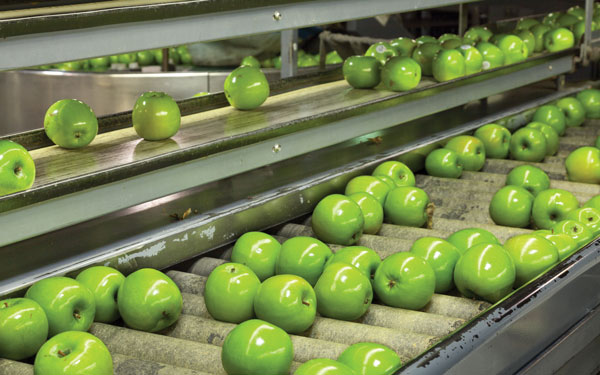Foreign Body Detection: Transparency in the food and beverage industry
- Like
- Digg
- Del
- Tumblr
- VKontakte
- Buffer
- Love This
- Odnoklassniki
- Meneame
- Blogger
- Amazon
- Yahoo Mail
- Gmail
- AOL
- Newsvine
- HackerNews
- Evernote
- MySpace
- Mail.ru
- Viadeo
- Line
- Comments
- Yummly
- SMS
- Viber
- Telegram
- Subscribe
- Skype
- Facebook Messenger
- Kakao
- LiveJournal
- Yammer
- Edgar
- Fintel
- Mix
- Instapaper
- Copy Link
Posted: 26 April 2016 | Stephanie Anthony, Commissioning Editor, New Food | No comments yet
Contamination can be a huge issue for food and beverage manufacturers, making foreign body detection systems extremely important – to save face and maintain customers’ trust. This year alone large companies such as Nestlé and Mars have had recalls after products were found to be/ potentially contaminated with glass pieces and plastic pieces respectively1,2 .


All businesses, irrespective of size, should take all reasonable precautions to ensure that the produce they supply meets safety requirements. While the precautions taken by small manufacturers may not be as extensive as those taken by a larger business, even small companies must – at every stage of the food or feed chain – take reasonable precautions to ensure that their produce meets food or feed safety requirements.
A foreign body is defined as an object or piece of extraneous matter that has entered (the manufacturing process/ end product) by accident or design. Glass and plastic are examples, but it also includes pests. Around 60% of complaints reported across a range of UK and European clients in the food service are related to foreign bodies3 . These unfortunate cases not only affect the consumers – as there can be potential health risks -but also the manufacturers, as it means a loss of sales and a waste of product and time.
The systems that can be implemented to try to prevent contamination are numerous; foreign body detection systems range from being relatively cheap to install, to the more complex (and as such more expensive) systems. Some examples are sieving methods, magnets and optical sorting. Technologies from the medical sector have also proved to be useful – for example x-ray and ultrasound technology can both be used to detect contaminants in the production line.
These systems can also be used to whittle out products that don’t match the specifications set for the final product – e.g. size and shape – or identify damaged product before it can reach consumers. Some systems are advanced enough to detect chemical composition and, as such, can identify chemical contaminants such as allergens.
It is important that the systems implemented are non-destructive and do not cause the issues that they are trying to prevent. As such, many systems involve the use of cameras and lasers – equipment that can monitor quality without touching the product4.
These systems are not always perfect though and, as such, recalls do still occur – as mentioned previously. This can be down to many things including the system itself as well as the application of the system. Sometimes these cases can even be deliberate; food processing chains are so complex that gaps can occur in the chain offering opportunity for issues to arise, and there are always people willing to take advantage of these gaps for their own gain. To avoid deliberate contamination, testing at multiple points in the processing chain is crucial – like a game of Chinese Whispers you cannot guarantee that what you start with will be what you finish with.
After a recall it is very important to ascertain when and how the contamination occurred – for this purpose foreign body detection systems can once again be used to help answer these questions. Sometimes recalls can be helpful in identifying issues with production – although of course it is always preferable to identify such issues prior to the product going to market.
Nowadays there is a much better link between consumers and producers than in the past. Businesses are legally required to inform their local authority if there is reason to believe that food or feed is not compliant with food or feed safety requirements5; most recalls are completely voluntary, and the companies work openly to get the contaminated products off shelves and out of sale as soon as possible.
Many authorities have a hand in making the industry more transparent. The FSA, for example, publishes lists of food incidents and details the manner in which they were handled6. The FDA also provide constantly updated information on recalls of foods and dietary supplements7 stating the reason for the recall, the exact products affected, as well as what the consumer can do. Preventing incidents is important for protecting consumers’ interests, ensuring food standards and safety, and maintaining trust in the food chain.
References
- New Food (2016) News – Industry News. Nestle recall http://www.newfoodmagazine.com/23236/news/industry-news/nestle-usa-recall-glass-contamination/
- New Food (2016) News – Industry News. Mars recalls chocolate products. http://www.newfoodmagazine.com/22851/news/industry-news/mars-recalls-chocolate-products-in-55-countries/
- Goodwin, D. (2014) http://www.newfoodmagazine.com/advent-calendar/foreign-body-contamination/
- Irudayarj, Joseph. Et al. (2008) Non-destructive testing of food quality. Wiley-Blackwell p.384.
- FSA advise on Food incidents for businesses – last accessed 12 April 2016. http://www.food.gov.uk/business-industry/food-incidents
- New Food (2016) News – Industry News. FSA list http://www.newfoodmagazine.com/23524/news/industry-news/fsa-list-food-incidents/
- FDA Recalls of Foods & Dietary Supplements
http://www.fda.gov/aboutfda/reportsmanualsforms/reports/economicanalyses/ucm363282.htm
About the author
Stephanie Anthony is the Editor of New Food magazine at Russell Publishing Ltd. Previously she was an Editorial Assistant for the same company, working across the diverse range of magazines they offer. She has a batchelors degree in Biosciences and Fine and Applied Arts from Canterbury Christ Church University.









